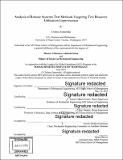| dc.contributor.advisor | Kamal Youcef-Toumi and Roy Welsch. | en_US |
| dc.contributor.author | Zarnowski, Chelsea. | en_US |
| dc.contributor.other | Sloan School of Management. | en_US |
| dc.contributor.other | Massachusetts Institute of Technology. Department of Mechanical Engineering. | en_US |
| dc.contributor.other | Leaders for Global Operations Program. | en_US |
| dc.date.accessioned | 2019-10-11T22:25:14Z | |
| dc.date.available | 2019-10-11T22:25:14Z | |
| dc.date.copyright | 2019 | en_US |
| dc.date.issued | 2019 | en_US |
| dc.date.issued | 2019 | en_US |
| dc.identifier.uri | https://hdl.handle.net/1721.1/122596 | |
| dc.description | Thesis: M.B.A., Massachusetts Institute of Technology, Sloan School of Management, 2019, In conjunction with the Leaders for Global Operations Program at MIT | en_US |
| dc.description | Thesis: S.M., Massachusetts Institute of Technology, Department of Mechanical Engineering, 2019, In conjunction with the Leaders for Global Operations Program at MIT | en_US |
| dc.description | Cataloged from PDF version of thesis. | en_US |
| dc.description | Includes bibliographical references (pages 51-52). | en_US |
| dc.description.abstract | The robotics industry continues to grow rapidly. More industries are moving towards automation and are looking for the robotics industry to support the industry 4.0 movement. Due to a push by consumers, robotics producers are getting pressured by customers to deliver higher quality products faster. Motivated by Cost of Quality and Design of Experiments methods, the author breaks down the production systems test of robot manufacturing to identify areas for the focus of experimentation to improve quality and resource utilization. Considering connections between First Pass Yield and Field Failure Rates, the focus on quality improvement demonstrates the strong ties from the robot manufacturers to the final end user customers. By analyzing the robotic production and test systems, the author identifies three areas for the focus of experiments: 1) Test effectivity, 2) Component failure, 3) Robot system and test cell matching. Within each of these areas further analysis then identifies the experimental topics that can be developed through modified Design of Experiments steps to improve quality and remove the waste from failures and production system issues. | en_US |
| dc.description.statementofresponsibility | by Chelsea Zarnowski. | en_US |
| dc.format.extent | 52 pages | en_US |
| dc.language.iso | eng | en_US |
| dc.publisher | Massachusetts Institute of Technology | en_US |
| dc.rights | MIT theses are protected by copyright. They may be viewed, downloaded, or printed from this source but further reproduction or distribution in any format is prohibited without written permission. | en_US |
| dc.rights.uri | http://dspace.mit.edu/handle/1721.1/7582 | en_US |
| dc.subject | Sloan School of Management. | en_US |
| dc.subject | Mechanical Engineering. | en_US |
| dc.subject | Leaders for Global Operations Program. | en_US |
| dc.title | Analysis of robotic systems test methods targeting test resource utilization improvement | en_US |
| dc.type | Thesis | en_US |
| dc.description.degree | M.B.A. | en_US |
| dc.description.degree | S.M. | en_US |
| dc.contributor.department | Sloan School of Management | en_US |
| dc.contributor.department | Massachusetts Institute of Technology. Department of Mechanical Engineering | en_US |
| dc.contributor.department | Leaders for Global Operations Program | en_US |
| dc.identifier.oclc | 1119537670 | en_US |
| dc.description.collection | M.B.A. Massachusetts Institute of Technology, Sloan School of Management | en_US |
| dc.description.collection | S.M. Massachusetts Institute of Technology, Department of Mechanical Engineering | en_US |
| dspace.imported | 2019-10-11T22:25:13Z | en_US |
| mit.thesis.degree | Master | en_US |
| mit.thesis.department | Sloan | en_US |
| mit.thesis.department | MechE | en_US |
